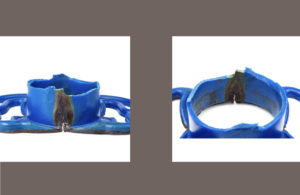Medical tubing makers need to carefully control and tune their extrusion tooling to very tight tolerances in a cost-efficient manner. Flow channel geometry plays a critical role.
Denis Finn, Guill Tool & Engineering

Medical tubing and jacketed products must be produced to conform to very tight tolerances. It’s often necessary to inspect wall thicknesses and diameters to tolerances lower than 0.0004 in./.01 mm. Polymers used in the medical industry may also be extremely expensive. Medical tubing makers need to carefully control and tune extrusion systems to produce demanding products in a cost-efficient manner. This is especially important for multi-layer and/or multi-lumen constructions.
The flow channel geometry the polymer flows through is a critical component of a well-designed extrusion system. Residence time, or the amount of time the polymer flows through the die assembly, should be considered in an effort to avoid burning and stagnation issues. Channels that are too large means the polymer’s exposure time to processing temperatures could begin to degrade the polymer. A too restrictive geometry often means the system will run at high pressures, often limiting production speeds. Along with this, users can encounter dead spots that prevent the material from flowing freely. If this is not corrected, the material can become completely degraded.
While flow channel geometry challenges can occur with all polymers, this becomes a serious problem in the medical industry due to the usage of expensive materials. Also, medical products commonly use barium sulfate, a radiopaque substance which allows the finished product to be visible on X-ray scans. When barium sulfate is co-extruded with high-temperature materials like fluoropolymers, the flow channels must be engineered to ensure the barium sulfate does not degrade. Dead spots and high residence time will cause the barium sulfate to yellow and ruin the product.
The sensors and feedback the system provides should be checked and doubled checked to ensure the polymer is properly processed. The temperature of the polymer flowing the die cavity could differ greatly from the thermocouple reading. As we know, the thermocouple is a sensor that measures the temperature of the die assembly. In most cases, the sensor is not directly reading the temperature of the polymer but is installed on the outside housing of a die assembly. A considerable thermal gradient can occur between the polymer and the thermocouple, giving false confidence that the polymer is being properly processed. Since the polymer temperature could actually be colder or hotter than what is indicated, it is imperative to take physical measurements from the melt stream when working with fragile materials or establishing recipes for the line. To do this, you should take the measurements while at production speed.
As the polymer begins to travel through the restrictive flow channels, it will develop heat from viscous dissipation. The faster you go, the more heat the polymer’s flow will contribute to the system, if everything else stays the same. Close monitoring is critical for many thermally sensitive materials like ethylene vinyl alcohol (EVOH), where gels and other degradation may occur. For example, you might look at the thermocouple and see 300 ºC but measure the direct temperature and get 330 ºC. In this case, you need to adjust the thermocouple settings to get the right melt temperatures.
Materials may also be prone to melt fracture, a phenomenon that produces an unsatisfactory surface finish on the product. Utilizing proper tooling sizes and processing parameters will avoid these troublesome issues.
According to Bill Conley, our national sales manager, if the extruder is running very slowly, we can also offer dual, triple or quadruple output dies. Instead of getting another line, you are effectively doubling the extrusion system to double or even quadruple your production. In this way, you save a lot of money on equipment and processing personnel.
Denis Finn is a product development engineer at Guill Tool & Engineering (West Warwick, R.I.). Guill designs and manufactures extrusion tooling for various thermoplastic and elastomeric applications.
The opinions expressed in this blog post are the author’s only and do not necessarily reflect those of Medical Design and Outsourcing or its employees.

